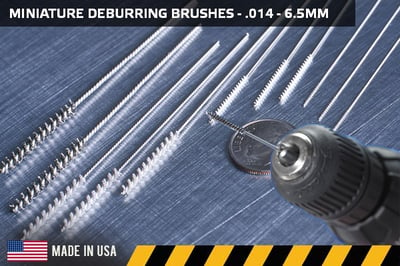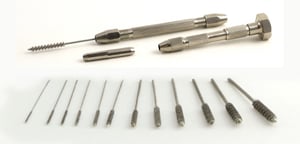 Miniature deburring brushes help keep small-diameter holes from becoming big-time finishing problems. These miniature metalworking tools remove small burrs that can cause part misalignments. They also perform internal cleaning and produce the proper edge radius on machined holes with small diameters.
Miniature deburring brushes help keep small-diameter holes from becoming big-time finishing problems. These miniature metalworking tools remove small burrs that can cause part misalignments. They also perform internal cleaning and produce the proper edge radius on machined holes with small diameters.
Brush Research Manufacturing (BRM), maker of the Flex-Hone® tool, supplies different types of miniature deburring brushes. These tools can be driven by hand or used under power, but there are some basic operating instructions that you need to follow. Here are some tips for selecting and using these tools.
Choose the Best Brush for the Job
Manufacturers and metalworkers have a choice of miniature deburring tools.
- Series 81A brushes feature an all-stainless steel construction and are great for removing chips, breakout burrs, micro burrs, and other surface imperfections. Use them with workpieces made of cast iron or steel.
- Series 81AY brushes have twisted-in-wire abrasive nylon filaments. They’re available with silicon carbide (SC) and aluminum oxide (AO) abrasive in a range of grit sizes for various base materials and degrees of surface improvement.
BRM also supplies Series 81AD miniature deburring brushes with diamond abrasive filaments for harder materials such as ceramic, glass, and aerospace alloys.
Decide How to Use the Tool
Series 81A and Series 81AY miniature deburring brushes can be driven by hand or used under power. When deciding how to use these tools, consider the following:
- Small-diameter brushes are better-suited for hand use.
- Larger-diameter brushes work well under power.
No matter how you use these metalworking tools, always wear eye protection.
Drive the Brush by Hand
 If you decide to drive a mini deburring brush by hand, mount the stem securely in a pin vise. BRM supplies two types of pin vises that are made from solid brass and are nickel-plated.
If you decide to drive a mini deburring brush by hand, mount the stem securely in a pin vise. BRM supplies two types of pin vises that are made from solid brass and are nickel-plated.
- Hexagonal pin vises are double-ended. They have a hexagonal locking collet and come with two reversible four-jaw chucks.
- Swivel types offer a unique swivel action that allows for precise and consistent control during deburring and finishing operations.
When you’re driving a miniature deburring brush by hand, keep these tool tips in mind.
- Grip the brush as close to the bristles as possible to accommodate the required stroke length.
- Avoid stem deflection.
Use the Tool Under Power
If you decide to use the brush under power instead, follow these safety tips:
- Mount the tool securely in a collet
- Never exceed 1200 RPM
For more information about BRM’s miniature deburring brushes, including brush sizes, visit this product page on our website. Note that you can purchase brushes Series 81A and 81AY brushes individually, or in cost-effective kits with a pin vise. Get this brochure to learn more about BRM’s miniature brush kits.









